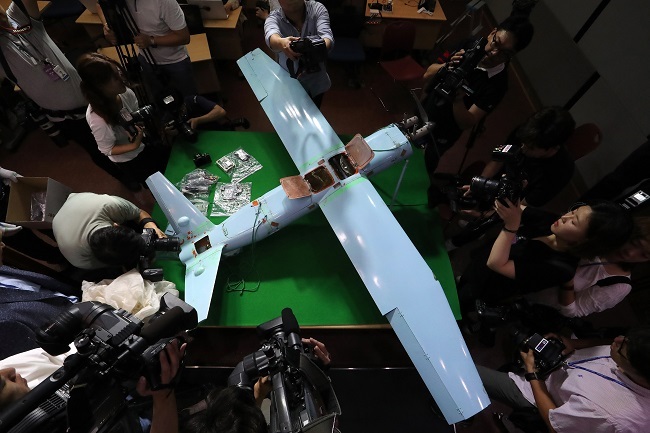A drone found earlier this month in South Korea was confirmed to have been sent by the North Korean military, possibly its intelligence agency, to spy on a US advanced missile defense system deployed in the South, Seoul’s military said Wednesday.
According to its investigation, the drone was flown on May 2 from Kumgang County, a small village located about seven kilometers north of the two Koreas’ border, and traveled about 490 kilometers until it crashed on a mountain near Injae, Gangwon Province of South Korea, where the device was found on June 13.
Designed for a reconnaissance mission, the device may have been employed by either the North’s corps-level units or Reconnaissance General Bureau, the communist state‘s intelligence agency that manages clandestine operations, the defense ministry said.

A crashed North Korean drone, which was found on June 13 near a mountain in Inje, Gangwon Province of South Korea, is shown during a press conference held by the Defense Ministry at its headquarters in Seoul on Wednesday. (Yonhap)
“We strongly condemn North Korea’s drone infiltration and urge them to stop such provocations,” said Army. Brig. Gen. Jeon Dong-jin, deputy director of operation at the Joint Chiefs of Staff, describing the North’s action as “a grave violation” of the two Korea’s armistice agreement.
Equipped with an advanced engine and enhanced batteries, the drone traveled about twice as far as a previous model found on Baengnyeongdo in 2014, according to the military. The engine displacement was expanded to 50cc from 35cc, with the fuel tank capacity more than doubled at 7.47 liters, it added.
The military also revealed that the drone was outfitted with components coming from six countries. Propelled by an engine made by Czech Republic, the drone used a South Korean servo motor, Canadian autopilot circuit board, American GPS system and Japanese A7R camera made by Sony.
The drone flew at a maximum altitude of 2.4 kilometers at an average speed of 90 kilometers per hour in a “straight-line pattern,” until it reached the site for Terminal High Altitude Area Defense battery in Seongju, North Gyeongsang Province, the military added.
The military confirmed that the drone carried about 551 photos of South Korean territory, including about 10 pictures of a THAAD battery. The images, however, were not transmitted to North Korea in realtime, the military analyzed.
“We believe that North Korea has yet to secure technology to send the images back home in realtime,” an anonymous official from Agency for Defense Development, a state agency for research and development of defense technology.
Although the found drone was mainly designed to acquire information on ground targets, the North could use smaller-size devices for biological attacks involving toxic materials such as Antrax, the military asserted.
“We believe North Korea has the capability to mount chemical weapons and explosives, instead of a camera. They can fly such drones into the South’s rear area,” a senior official at JCS said under the condition of anonymity.
Analysts, calling such a drone attack an “imminent threat,” criticized the South Korean military for having done little about it, while acknowledging the challenges in detecting and intercepting small drones with current surveillance.
After a North Korean drone was found to have flown over the presidential palace of Cheong Wa Dae and taken pictures of it in 2014, the South Korean military decided to ramp up efforts to purchase and develop low-altitude radars targeting drones. But the radars have yet to be fully deployed, particular at the border area.
“The military is in the process of developing a new system to detect and neutralize small-sized drones. We are doing our utmost to field extensive radar and other air-defense assets,” said defense ministry’s spokesman Moon Sang-kyun.
By Yeo Jun-suk (
jasonyeo@heraldcorp.com)




![[From the Scene] Monks, Buddhists hail return of remains of Buddhas](http://res.heraldm.com/phpwas/restmb_idxmake.php?idx=645&simg=/content/image/2024/04/19/20240419050617_0.jpg&u=20240419175937)

